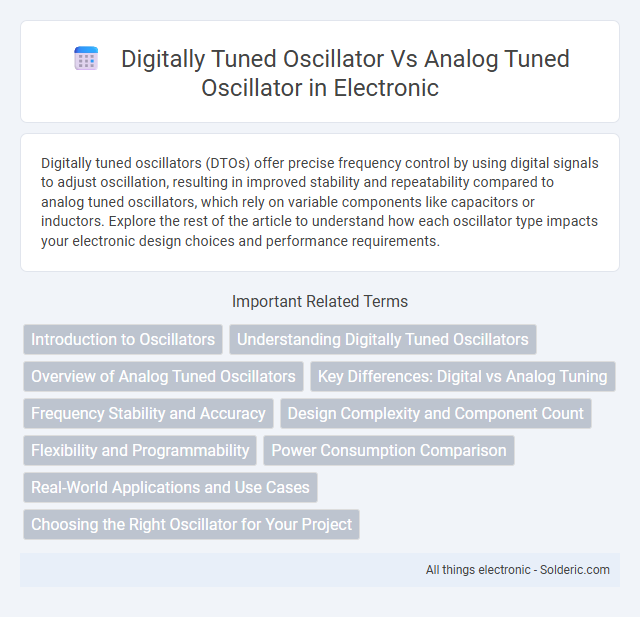Digitally tuned oscillators (DTOs) offer precise frequency control by using digital signals to adjust oscillation, resulting in improved stability and repeatability compared to analog tuned oscillators, which rely on variable components like capacitors or inductors. Explore the rest of the article to understand how each oscillator type impacts your electronic design choices and performance requirements.
Comparison Table
| Feature | Digitally Tuned Oscillator (DTO) | Analog Tuned Oscillator (ATO) |
|---|---|---|
| Tuning Precision | High, controlled by digital signals | Moderate, affected by component tolerance |
| Frequency Stability | Excellent, less sensitive to temperature | Dependent on analog components and temperature |
| Integration | Easy integration with digital circuits | Requires analog components, harder to integrate |
| Noise Performance | Lower phase noise with digital control | Generally higher phase noise |
| Power Consumption | Typically higher due to digital circuitry | Lower in simple analog designs |
| Complexity | Higher complexity due to digital control logic | Simpler design, fewer components |
| Speed of Tuning | Fast, near-instant digital adjustments | Slower, limited by analog components |
| Cost | Generally higher semiconductor cost | Lower component cost |
Introduction to Oscillators
Oscillators generate periodic signals essential for communication systems, clocks, and signal processing, with digitally tuned oscillators (DTOs) offering precise frequency control through digital signals. Analog tuned oscillators rely on continuous voltage or current variations for frequency adjustment, which may introduce noise and drift over time. Your choice between DTO and analog oscillators affects stability, accuracy, and integration capabilities in modern electronic applications.
Understanding Digitally Tuned Oscillators
Digitally tuned oscillators (DTOs) use digital control signals to precisely adjust frequency, offering greater stability and programmability compared to analog tuned oscillators (ATOs) that rely on variable physical components like capacitors or inductors. Your design benefits from DTOs' reduced susceptibility to temperature variations and aging effects, enabling more consistent performance in communication systems and signal processing. The digital nature also simplifies integration with modern microcontrollers, enhancing frequency accuracy and ease of tuning over traditional analog methods.
Overview of Analog Tuned Oscillators
Analog tuned oscillators rely on continuous voltage control for frequency adjustment, utilizing components like varactor diodes or LC circuits to set oscillation frequency. Their design offers simplicity and low phase noise, making them suitable for applications requiring stable and clean signals. However, analog oscillators can suffer from temperature drift and process variations, leading to less precise frequency control compared to digitally tuned counterparts.
Key Differences: Digital vs Analog Tuning
Digitally tuned oscillators use digital control signals to precisely adjust frequency, enabling fast switching and high stability with minimal drift over temperature variations. Analog tuned oscillators rely on continuous voltage control, making them more susceptible to noise, temperature changes, and slower frequency tuning speeds. Digital tuning offers enhanced repeatability and integration with modern digital systems, while analog tuning provides simplicity and lower initial cost in certain applications.
Frequency Stability and Accuracy
Digitally tuned oscillators (DTOs) offer superior frequency stability and accuracy due to their reliance on precise digital control circuits and temperature-compensated crystal oscillators (TCXOs), minimizing drift caused by environmental changes. Analog tuned oscillators depend on variable components like varactors and inductors, which are more susceptible to temperature variances and aging, leading to decreased frequency stability over time. You can expect DTOs to maintain consistent frequencies with higher accuracy in demanding applications, making them ideal for modern telecommunications and precision instrumentation.
Design Complexity and Component Count
Digitally tuned oscillators (DTOs) generally exhibit lower design complexity and reduced component count compared to analog tuned oscillators (ATOs), as DTOs rely on integrated digital circuits and programmable elements for frequency control. Analog tuned oscillators require numerous discrete components such as varactors, inductors, and resistors, increasing both the design intricacy and susceptibility to component tolerance variations. Your project benefits from DTOs' streamlined architecture and enhanced precision, which simplifies implementation in compact and scalable electronic systems.
Flexibility and Programmability
Digitally tuned oscillators offer superior flexibility and programmability compared to analog-tuned oscillators by leveraging digital control interfaces that allow precise frequency adjustments and easy integration with microcontrollers or digital signal processors. These oscillators enable dynamic frequency modulation and quick reconfiguration through software updates without hardware modifications, supporting a wide range of applications. In contrast, analog-tuned oscillators rely on fixed components such as varactors or inductors, limiting programmability and requiring physical changes for frequency adjustments.
Power Consumption Comparison
Digitally tuned oscillators typically consume less power than analog tuned oscillators due to their reliance on digital circuits that allow precise control and lower leakage currents. Analog tuned oscillators often require continuous bias currents and tuning voltage, leading to higher power dissipation, especially in high-frequency applications. Your choice between these oscillator types can significantly impact power efficiency, with digitally tuned solutions favored for low-power, battery-operated devices.
Real-World Applications and Use Cases
Digitally tuned oscillators (DTOs) offer precise frequency control and programmability, making them ideal for software-defined radios, wireless communication systems, and instrumentation where rapid frequency switching and accuracy are critical. Analog tuned oscillators (ATOs), with their simpler design and lower power consumption, are commonly used in traditional radio receivers, audio oscillators, and basic signal generators where stability and low noise performance are prioritized. Your choice depends on the application's need for flexibility, frequency agility, and integration with digital control systems versus analog simplicity and robustness.
Choosing the Right Oscillator for Your Project
Choosing the right oscillator for your project depends on factors like frequency stability, tuning precision, and environmental conditions. A digitally tuned oscillator offers high accuracy, programmability, and immunity to temperature variations, making it ideal for applications requiring precise frequency control. In contrast, analog tuned oscillators provide simplicity and low cost but may suffer from drift and lower stability under varying conditions.
digitally tuned oscillator vs analog tuned oscillator Infographic

 solderic.com
solderic.com